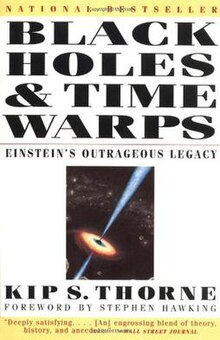Black Holes and Time Warps

First edition cover
|
|
| Author | Kip S. Thorne |
|---|---|
| Illustrator | Matthew Zimet |
| Cover artist | Jacques Chazaud |
| Subject | Physics: general relativity, quantum gravity, black holes |
| Genre | Non-fiction |
| Published | 1994 |
| Publisher | W. W. Norton & Company |
| Pages | 619 pp. |
| ISBN | |
| 530.1'1 93-2014 | |
| LC Class | QC6.T526 1993 |
| Followed by | The Science of Interstellar (2014) |
Black Holes & Time Warps: Einstein's Outrageous Legacy is a 1994 popular science book by physicist Kip Thorne. It provides an illustrated overview of the history and development of black hole theory, from its roots in Newtonian mechanics until the early 1990s.
Over fourteen chapters, Thorne proceeds roughly chronologically, tracing first the crisis in Newtonian physics precipitated by the Michelson–Morley experiment, and the subsequent development of Einstein's theory of special relativity (given mathematical rigor in the form of Minkowski space), and later Einstein's incorporation of gravity into the framework of general relativity. Black holes were quickly recognized as a feasible solution of Einstein's field equations, but were rejected as physically implausible by most physicists. Work by Subrahmanyan Chandrasekhar suggested that collapsing stars beyond a certain mass cannot be supported by degeneracy pressure, but this result was challenged by the more prestigious Arthur Stanley Eddington, and was not fully accepted for several decades. When the reality of objects which possess an event horizon finally achieved broad acceptance, the stage was set for a thorough investigation into the properties of such objects, yielding the surprising result that black holes have no hair—that is, that their properties are entirely determined by their mass, spin rate, and electrical charge.
Proceeding separately from theoretical research into relativity, and with the refinement of radio astronomy, astrophysics began to produce unusual observations of extremely intense radio sources, which were apparently located outside of the Milky Way. In consultation with theoretical physicists, it became apparent that the only sensible explanation for these sources were extremely large black holes residing in the cores of galaxies, producing intense radiation as they fed and, in the case of quasars, blasting out incredibly powerful jets of material in opposite directions, heating the surrounding galactic gas until it glowed in radio frequencies.
...
Wikipedia
